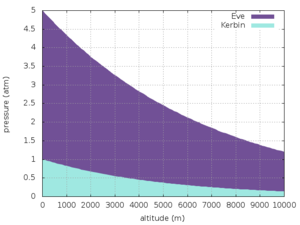Difference between revisions of "Eve/pl"
| Line 1: | Line 1: | ||
{{Planetbox | {{Planetbox | ||
| − | |Class= | + | |Class=Planeta |
|File=Eve_map.png | |File=Eve_map.png | ||
|Parent=Kerbol | |Parent=Kerbol | ||
| Line 30: | Line 30: | ||
'''Eve''' jest drugą [[planetą]] w systemie [[Kerbol]] Jak równie drugim co do wielkości obiektem orbitującym gwiazdę. Ma kolor fioletowy. Posiada jeden mały księżyc, będący asteroidą złapaną w studnię grawitacyjną planety. Księżyc nazywany jest '''[http://kspwiki.nexisonline.net/wiki/Gilly/pl Gilly]'''. | '''Eve''' jest drugą [[planetą]] w systemie [[Kerbol]] Jak równie drugim co do wielkości obiektem orbitującym gwiazdę. Ma kolor fioletowy. Posiada jeden mały księżyc, będący asteroidą złapaną w studnię grawitacyjną planety. Księżyc nazywany jest '''[http://kspwiki.nexisonline.net/wiki/Gilly/pl Gilly]'''. | ||
| − | Eve | + | Eve jest planetą najbliższą [http://kspwiki.nexisonline.net/wiki/Kerbin/pl Kerbinowi], i najłatwiejszą planetą do osiągnięcia. Wymaga najmniej delta-v z pośród wszystkich planet. Wielkością zbliżona do Kerbinu, posiada dużą grawitację, a gęsta atmosfera ułatwia lądowanie, jednocześnie utrudniając start z powierzchni. |
== Topography == | == Topography == | ||
Revision as of 11:07, 1 November 2012
Eve jest drugą planetą w systemie Kerbol Jak równie drugim co do wielkości obiektem orbitującym gwiazdę. Ma kolor fioletowy. Posiada jeden mały księżyc, będący asteroidą złapaną w studnię grawitacyjną planety. Księżyc nazywany jest Gilly.
Eve jest planetą najbliższą Kerbinowi, i najłatwiejszą planetą do osiągnięcia. Wymaga najmniej delta-v z pośród wszystkich planet. Wielkością zbliżona do Kerbinu, posiada dużą grawitację, a gęsta atmosfera ułatwia lądowanie, jednocześnie utrudniając start z powierzchni.
Contents
Topography
|
Eve has several oceans and large, flat continents with a few mountain peaks. There is a distinctly large crater in the western hemisphere. The surface looks like purple sand dunes. |
Atmosphere
|
Eve's atmosphere begins at 97,500m. It fades exponentially with increasing altitude, as do the atmospheres of Kerbin and Duna, but it is a very thick atmosphere; at 11,250 m, it's as thick as Kerbin's atmosphere at sea level (1 atm), and at Eve sea level the atmospheric pressure is 5 atm. In general, the atmospheric pressure on Eve at an altitude expressed in meters is:[1] One observed deceleration profile is: 130 m/s at 11 KM, 110 m/s at 8.5 KM, 100 m/s at 7.5 KM, 90 m/s at 6 KM, 80 m/s at 4.3 KM. From within Eve's atmosphere, the sky appears indigo during nighttime. During dawn and dusk, the sky is green. The atmosphere is possibly composed of iodine, given its purple coloration. Jet engines function in Eve's atmosphere, to the extent of making noise and consuming fuel, but do not produce useful thrust, due to lack of oxygen to burn. |
Natural Satellites
Eve's only natural satellite is the tiny captured asteroid Gilly in a highly eccentric and inclined orbit. Gilly's surface is currently bugged, and it is challenging to land there.
Orbital Statistics
The geosynchronous orbit of Eve is at an altitude of 10373.195 km above Eve. The speed of the satellite is 858.95 m/s and it has an orbital periode resonating with 1 Eve day (22.5 hours or 81000 seconds.) For a semisynchronous orbit of ½ Eve day (11.25 hours or 40500 seconds) an orbit of 6275.676 km above Eve is needed with a velocity of 1082.2 m/s.
Reference Frames
Rotational/Inertial transition: 100,000? m
| Warp | Minimum Altitude |
|---|---|
| 1x | 0 m |
| 5x | 30,000 m |
| 10x | 30,000 m |
| 50x | 60,000 m |
| 100x | 120,000 m |
| 1,000x | 240,000 m |
| 10,000x | 480,000 m |
| 100,000x | 600,000 m |
Gallery
- Eve sky surface.png
Eve's sky at the surface.
Changes
- Initial Release
Notes
- ↑ A nuclear engine has a specific impulse of 220 in 1 atm or higher, 800 in vacuum, and the following at various Eve altitudes:
altitude (m) 11263 11268 11322 11598 11896 12200 12799 13868 14586 15292 16725 18711 22800 23556 32000 38000 43000 51963 specific impulse 220 220.2 224.6 246.9 269.9 292.4 334.0 400.0 438.8 473.4 533.7 600.2 688.2 699.8 769.8 787.3 793.8 798.3





